Curious about the squirrels in Montana? We’re about to dive into the lives of these furry creatures in the Treasure State. They may be small, but squirrels cause extensive damage in urban and rural areas.
We’ll cover the different species of squirrels found in Montana, from tree squirrels to ground squirrels. You’ll learn about effective trapping, shooting techniques, and other methods to keep their populations in check.
- Related article: Montana Nature Encounters
Why should you care about Montana’s squirrel population? The impact of these rodents on local ecosystems and agriculture is more significant than you might think. Stick around to find out how people manage squirrel problems and protect their homes and crops.
6 Key Takeaways on Montana’s Squirrels
- Squirrels have caused much damage and health issues in Montana. This is especially true in urban areas.
- Trapping and shooting are legal methods for controlling squirrel populations in Montana.
- Montana has various tree squirrel species, with two native and two exotic species.
- Red squirrels are vital to Montana’s northern forests, serving as a key food source and ecosystem stabilizer.
- Montana is home to six species of ground squirrels, with Richardson Ground Squirrels being the most common.
- There are numerous other ways to control squirrels at home, including fencing and crop rotations.
What You Need to Know About Montana Squirrels
Squirrels are a common sight in Montana and key players in the ecosystem. We’ll explore what makes them unique and how they thrive in the state’s varied landscapes.
How Does Squirrel Activity Affect Montana?
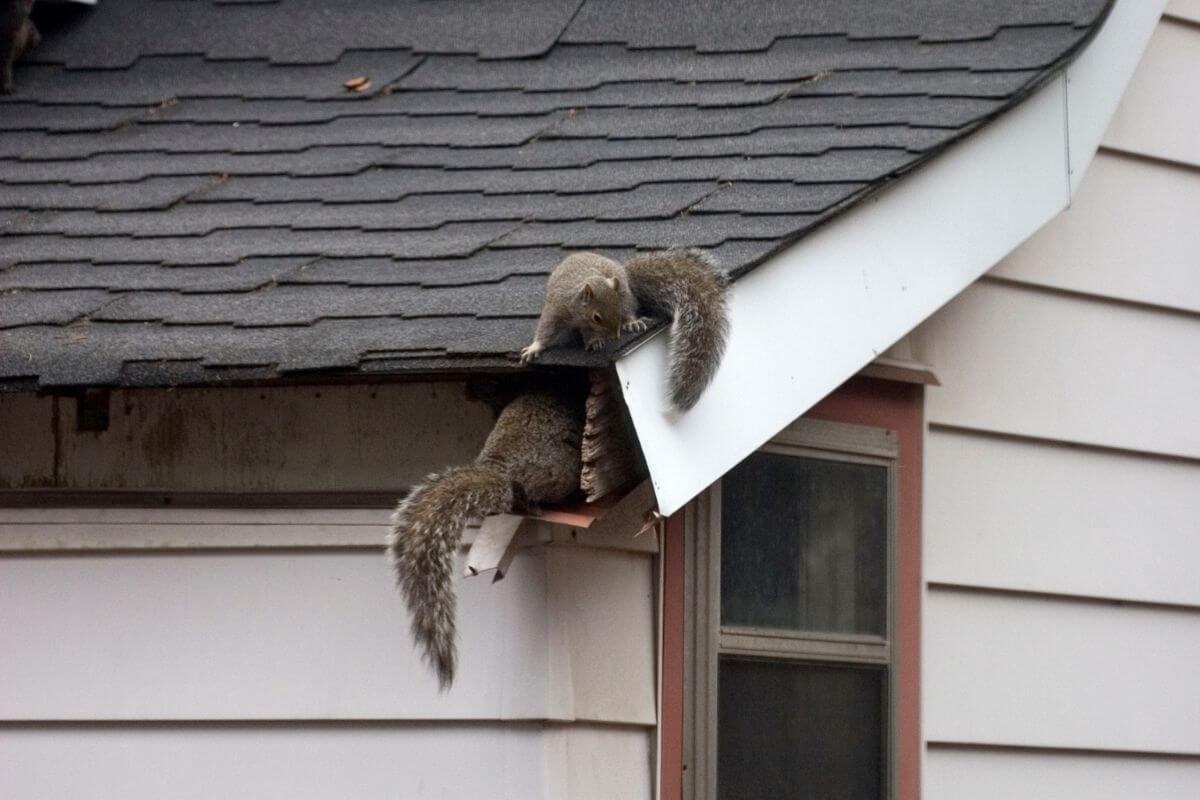
Tree squirrels, especially the imported fox squirrels, have become a significant issue in Montana. These exotic squirrels lack predators in cities. They have multiplied to troublesome levels. Most complaints and damage reports in towns and cities are attributed to them.
Let’s take a look at the problems squirrels bring to Montana:
- Invasion of Living Spaces – Fox squirrels are making their way into homes, sheds, and garages, causing a ruckus. They enter through chimneys, stove pipes, and any opening, often leading to difficult and costly removal.
- Destruction of Property – Squirrels don’t hold back once they’re inside properties. Insulation, rafters, and electric wires are all at risk of damage, which can be dangerous and expensive to fix.
- Eating Habits – Squirrels feast on everything from bird feed to garbage outdoors, not to mention the damage they do to gardens and crops. In urban areas, this means ruined gardens and lawns. In rural areas, it’s agricultural devastation. Hay alone suffers losses of over $15 million annually due to squirrel damage.
- Health Concerns – It’s not just about the damage they cause. Ground squirrels and prairie dogs can carry fleas that transmit diseases, including the bubonic plague. This adds another concern, especially for pet owners, as pets can bring infected fleas back home.
Dealing with squirrel problems goes beyond fixing a hole in the roof. It’s about understanding and managing the risks they pose to property and health. Squirrels demand our attention and a proactive approach to controlling their numbers and access to our spaces.
How Does Montana Control Squirrel Numbers?
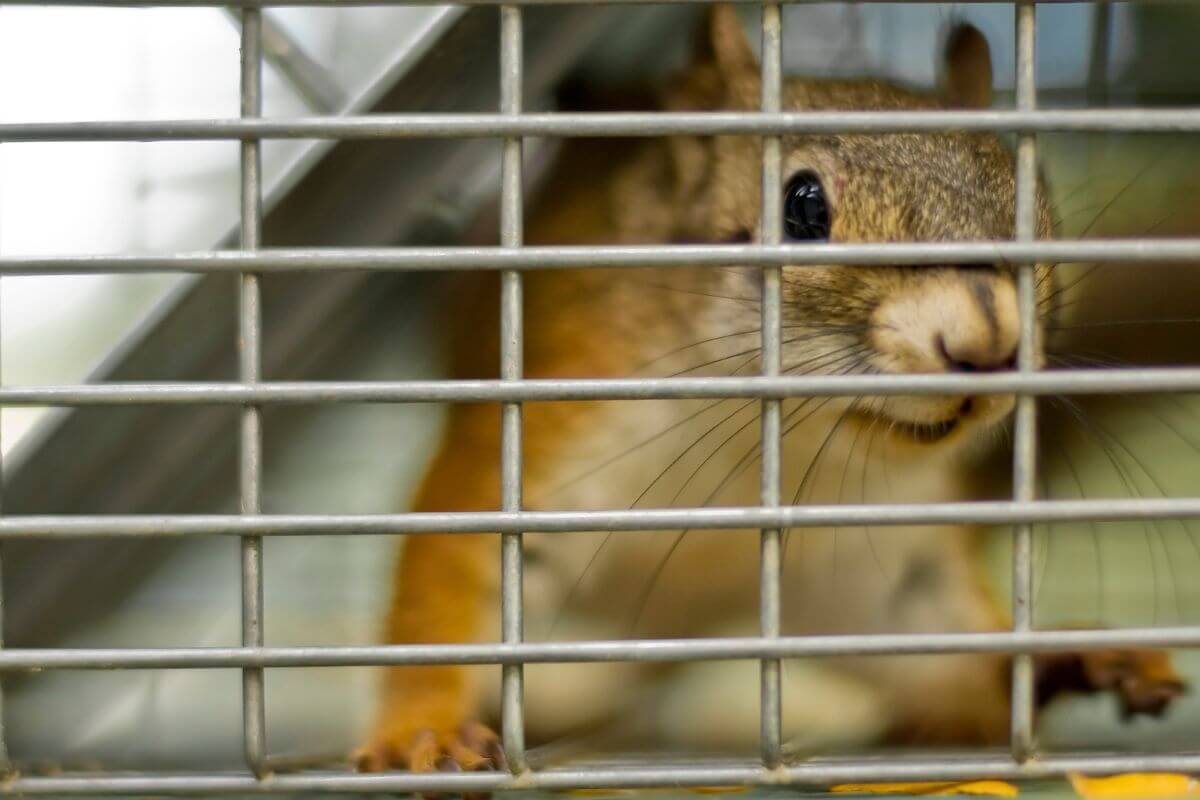
Trapping and shooting squirrels in Montana is the best way to control their numbers when they are a nuisance. People can hunt predatory animals and non-game species, such as tree and ground squirrels, without a license. They can do this throughout the year.
Trapping is a practical way to control ground squirrels. It’s especially useful in places with small populations or in urban areas. You can use small wire-mesh live traps, rat traps, or Conibear #110 body traps, which are all quite easy to set up. These traps can be baited with common foods like sunflower seeds, oatmeal, grain, or peanut butter. This makes them attractive to squirrels.
Live traps are usually available at garden supplies, sporting goods, or feed stores. They offer a humane way to catch squirrels, allowing you to release them far away from your property. This method is particularly useful for removing squirrels without harming them.
Shooting is another option to control squirrels, especially small squirrel populations. However, it’s important to note that discharging firearms is illegal and unsafe in many cities. But, using air rifles or pellet guns might be a legal and safe way to deal with squirrels after checking your local ordinances. Just be aware that shooting can be time-consuming, and squirrels can quickly learn to avoid danger, becoming “gun-shy.”
Before you start trapping or shooting squirrels, consider the safety and legal aspects, both for yourself and the animals. This approach to managing squirrel populations can be effective and respectful of the wildlife around you.
What Are the Types of Tree Squirrels in Montana?
Montana is home to various tree squirrels, each with unique characteristics. There are two main types of native tree squirrels: the red squirrel and the northern flying squirrel. In addition to these native species, two exotic tree squirrel species have made their way to the state.
Let’s look closer at the different types of tree squirrels you can find in Montana.
1. Montana’s Red Squirrels
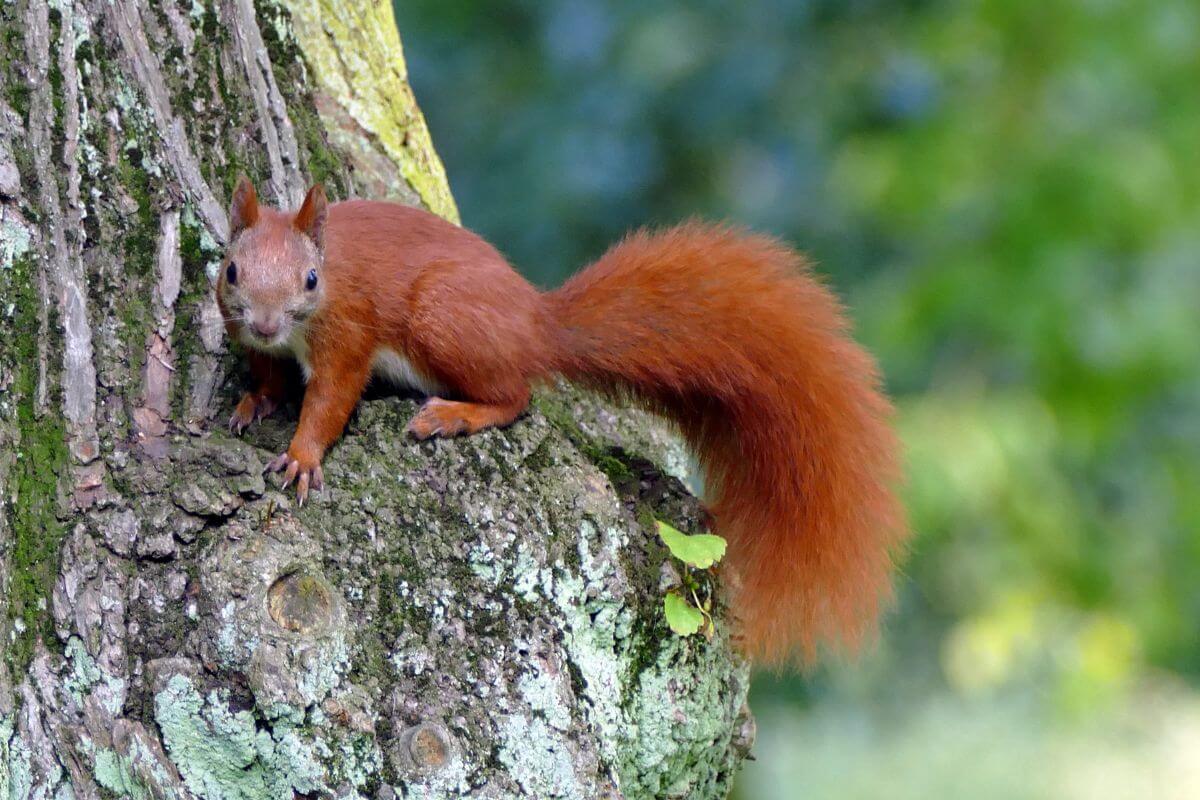
Montana’s red squirrels go by many names. These include pine squirrels, chickarees, boomers, fairy-diddles, spruce squirrels, and barking squirrels. These little creatures are found in northern coniferous forests and some hardwood forests. Despite their small size, they play a big role in the food chain.
Here’s what you need to know about Montana’s Red Squirrels:
- Size and Appearance – Red squirrels are the smallest tree squirrels, except for flying squirrels. They weigh between 5 and 9 ounces. As their name suggests, they are reddish-brown on their backs and have white underparts.
- Diet and Behavior – Red squirrels have a taste for mushrooms, fungi, and pine nuts. They are known for storing large amounts of pinecones. Their survival is closely tied to evergreen forests, with their population sizes changing based on the cone crops. They are also fiercely territorial, defending their one to six-acre patches to ensure they have the best food.
- Role in the Ecosystem – Red squirrels are a key food source for many predators in Montana, including hawks, owls, falcons, lynx, and weasels. They are also the primary prey for fishers, contributing to the balance of the ecosystem.
The presence of red squirrels in Montana’s forests highlights the intricate balance of nature. They greatly impact the environment around them.
2. Montana’s Northern Flying Squirrels
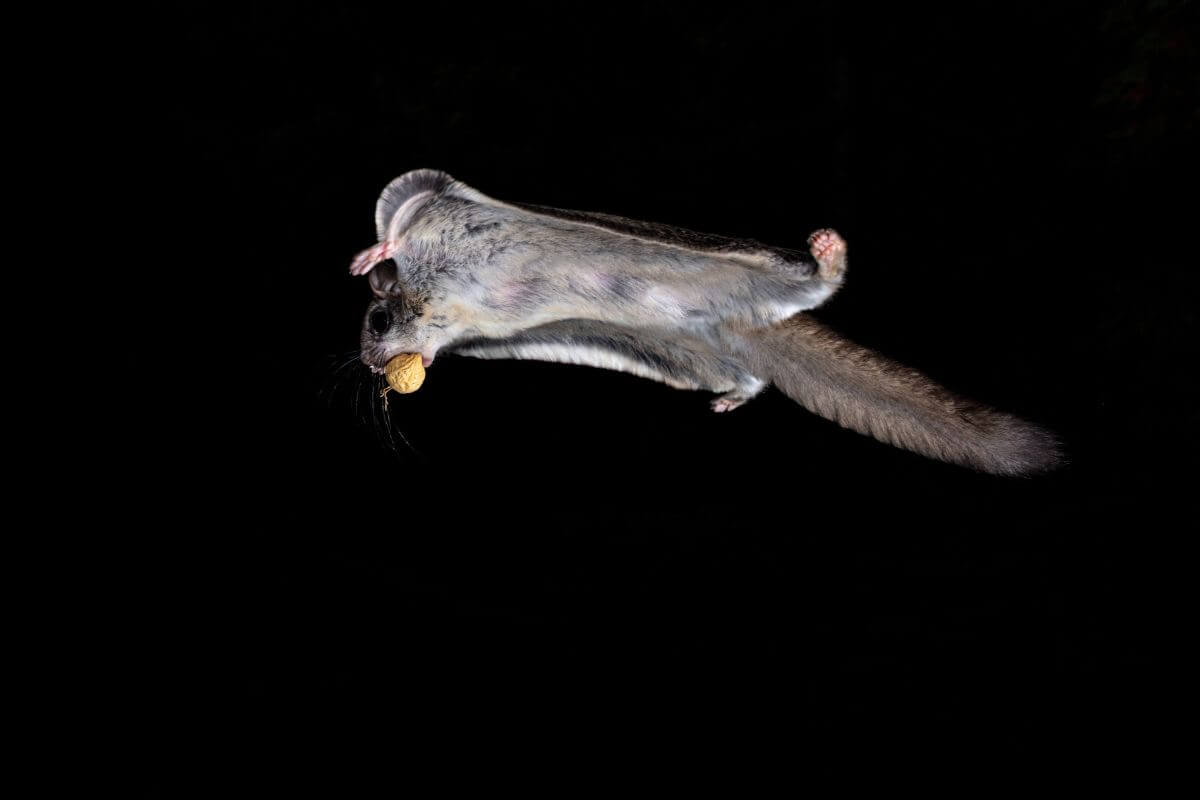
Despite their name, Northern Flying Squirrels in Montana do not fly. Instead, they glide through the air using their patagia, membranes stretching from their wrists to their ankles. This unique adaptation allows them to move from tree to tree with remarkable agility.
Let’s dive into the Northern Flying Squirrel’s characteristics:
- Size – Northern Flying Squirrels are lightweight, weighing between 75 and 140 grams and measuring between 275 and 342 mm in length. The tail is flattened and furry, making up 80% of the head and body length.
- Appearance – Northern Flying Squirrels have silky fur. It mixes grey and cinnamon brown. They also have distinct white-tipped belly hairs. They have large black eyes that aid in their nocturnal gliding adventures.
- Habitat – Northern Flying Squirrels are found in Montana’s forests. They prefer dense, wooded areas that offer many chances for gliding.
- Gliding Abilities – Northern Flying Squirrels can glide gracefully for up to 48 meters between trees despite being clumsy on the ground, thanks to their patagia.
When studying Northern Flying Squirrels, note their differences from the southern ones. Southern squirrels are smaller, with white belly hairs that extend to the base.
3. Montana’s Fox Squirrels
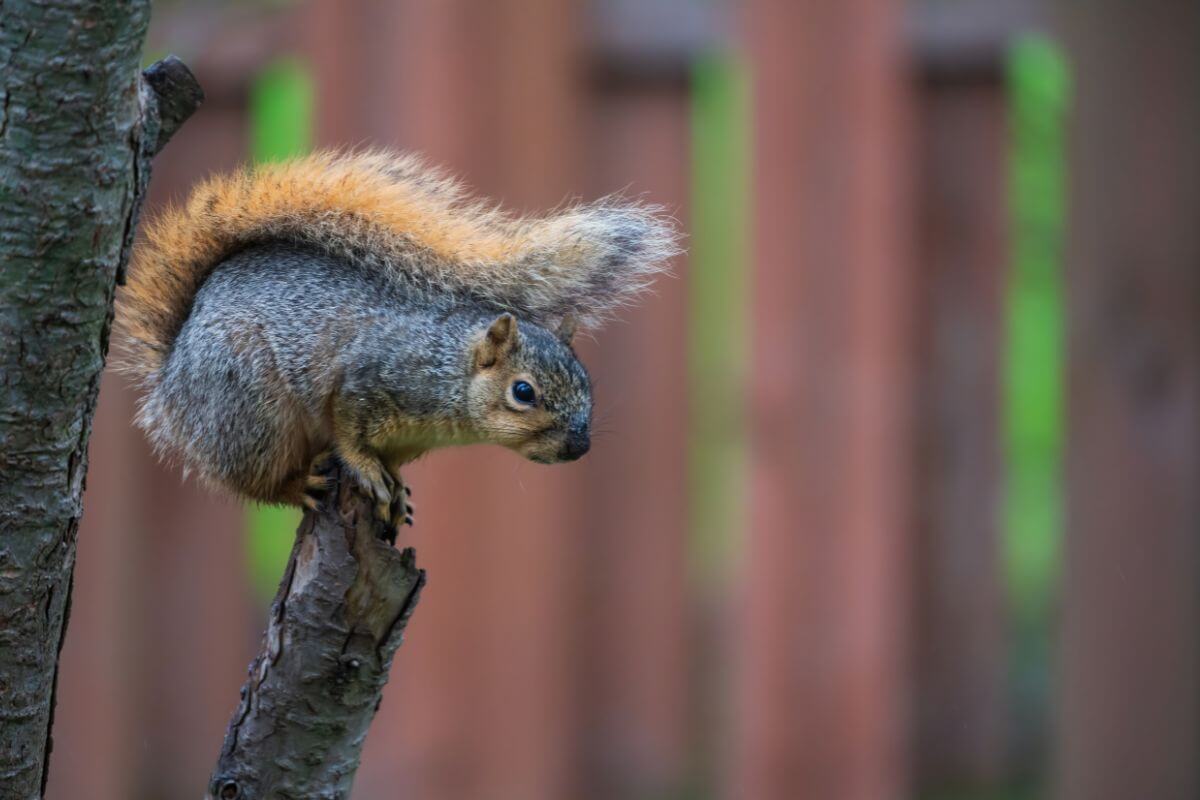
Montana is witnessing a new resident making themselves at home — the Fox Squirrel. These creatures originally hail from regions stretching the Mississippi River to the Atlantic. They have been trekking westward over the last 50 years, with some even getting a helping hand from humans.
Things to know about Montana’s Fox Squirrels:
- Size and Appearance – Fox squirrels are the biggest tree squirrels in the U.S., weighing up to 3 pounds. They come in various colors, from deep black to light gray to rusty brown. Their distinctive features include shorter, thicker, more rounded ears.
- Habitat and Diet – Fox squirrels strongly prefer woodlands, thriving in areas that gray squirrels avoid. Their diet is diverse, including crops like corn and wheat and the more traditional fare of acorns and nuts. They also taste insects, making their diet even more varied.
Despite the occasional issues they may cause, many people in Montana have developed a fondness for these lively creatures. Watching them playfully chase each other through trees and parks has become a beloved pastime for some.
4. Eastern Gray Squirrels in Montana
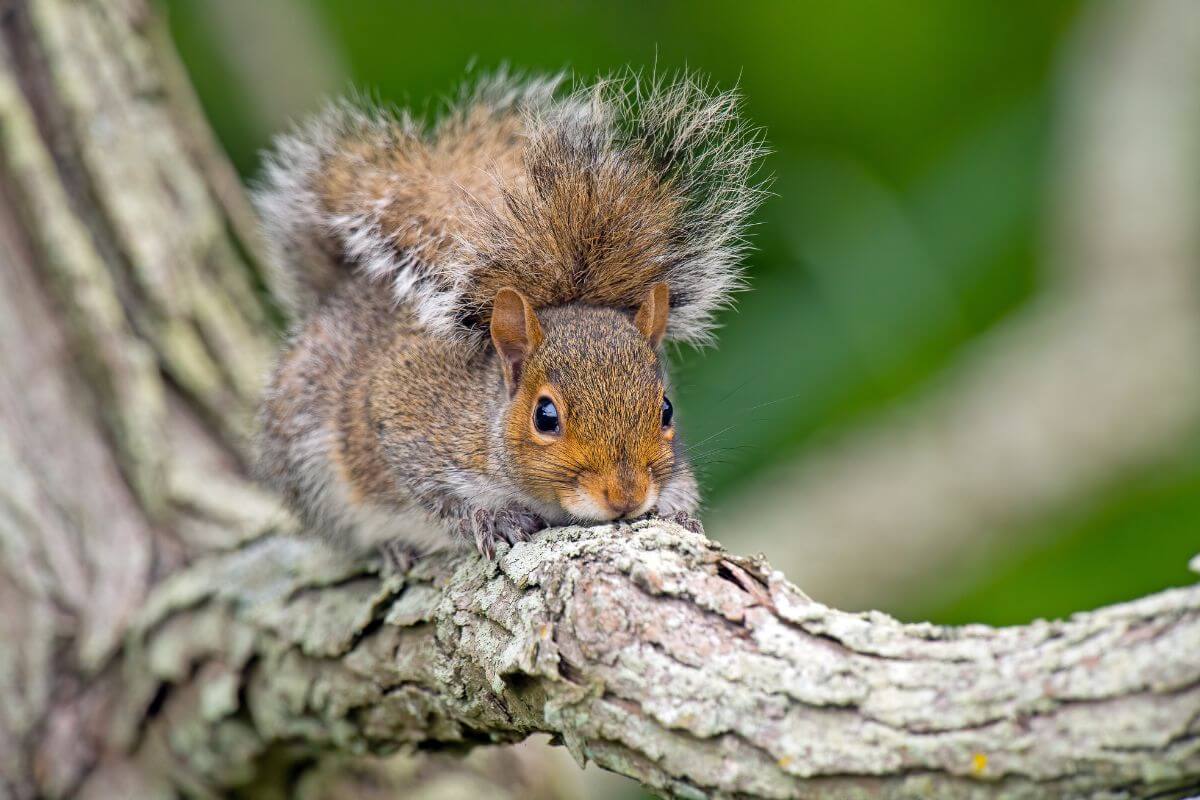
Eastern Gray Squirrels in Montana are known for their adaptable nature. They are popular game animals in the U.S., with more than 40 million hunted annually.
Here’s what you need to know about the Eastern Gray Squirrels in Montana:
- Size – Gray squirrels are of intermediate size, falling between fox squirrels and red squirrels. They can weigh up to 1.65 pounds.
- Color – Most gray squirrels are gray, as their name suggests. However, Montana is home to small populations of melanistic (black) and white (including albino) gray squirrels.
- Morality – Gray squirrels are relatively free of bacterial and viral agents. Their main health threat is ectoparasite infestations. These infestations cause an annual squirrel mortality rate of about 50%.
- Habitat – Gray squirrels thrive in relatively mature, dense forests. As the percentage of forested land increases, so do gray squirrel numbers.
- Diet – Gray squirrels’ diet is diverse, like other tree squirrels. It includes acorns, seeds, fruits, and other mast.
The environment and food sources are important in Montana’s gray squirrel population. As the state continues to focus on conservation efforts, understanding the needs and habits of these squirrels becomes increasingly important.
What Are the Types of Ground Squirrels in Montana?
Montana is home to six ground squirrel species. They include the Uinta, Wyoming, golden-mantled, and thirteen-lined ground squirrels. This section will examine the other two most common ones, the Richardson and Columbian ground squirrels.
Montana’s Richardson Ground Squirrels
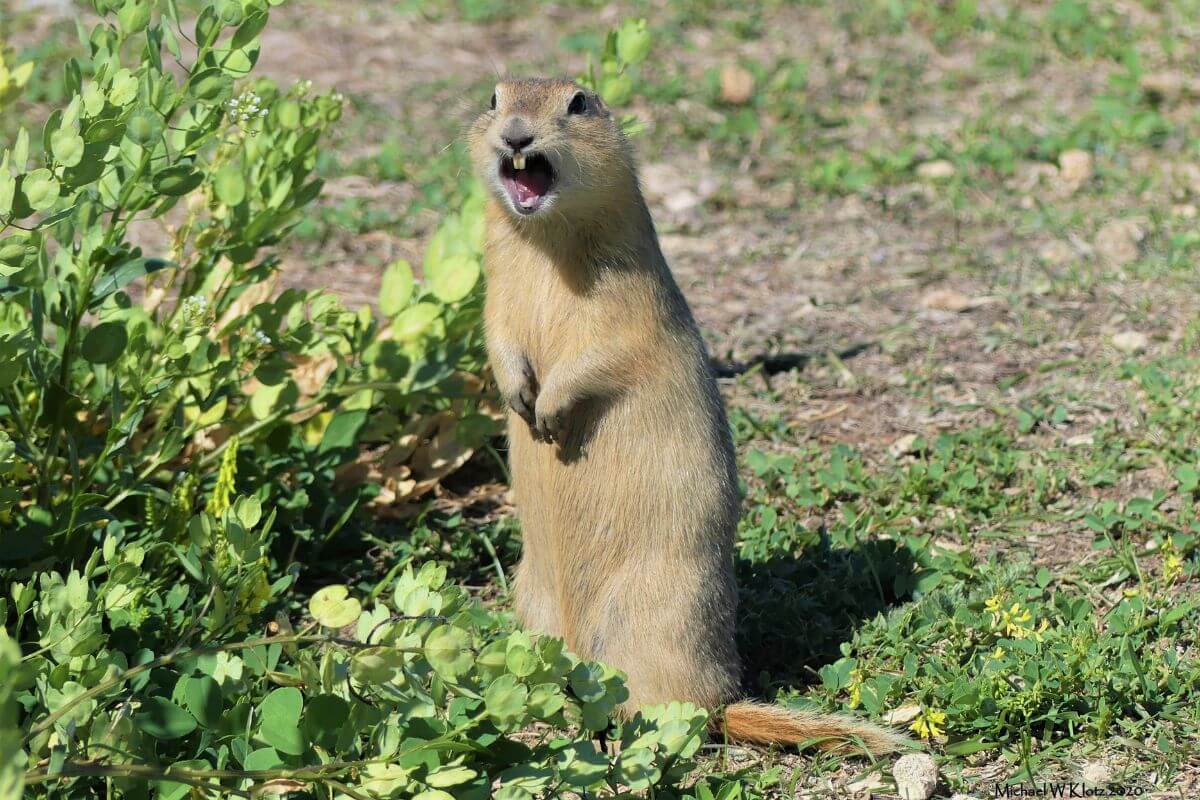
Richardson Ground Squirrels are small and stout with distinctive features. They are common across many landscapes, from croplands to urban settings.
In Broadwater County, the Richardson Ground Squirrel stands out with its appearance. It resembles a tree squirrel but has a shorter tail. This species is recognizable by its looks and habitat preferences, living in pastures and golf courses.
Some key characteristics that define the Montana Richardson Ground Squirrel:
- Size and Color – Richardson Ground Squirrels range from yellowish-tan to gray. They have a body length of about 8 inches and a tail spanning from 2 to 4 inches.
- Physical Features – Richardson Ground Squirrels have short ears and large black eyes. Their tails are not bushy. These traits help them survive in the dry prairies.
- Weight – Adult Richardson Ground Squirrels typically weigh between 11 to 18 ounces.
Despite their abundance, these squirrels face constant threats from predators. Creatures like Broad-winged hawks are key predators. They can cut the Richardson Ground Squirrel population by up to 15% in one season.
Montana’s Columbian Ground Squirrels
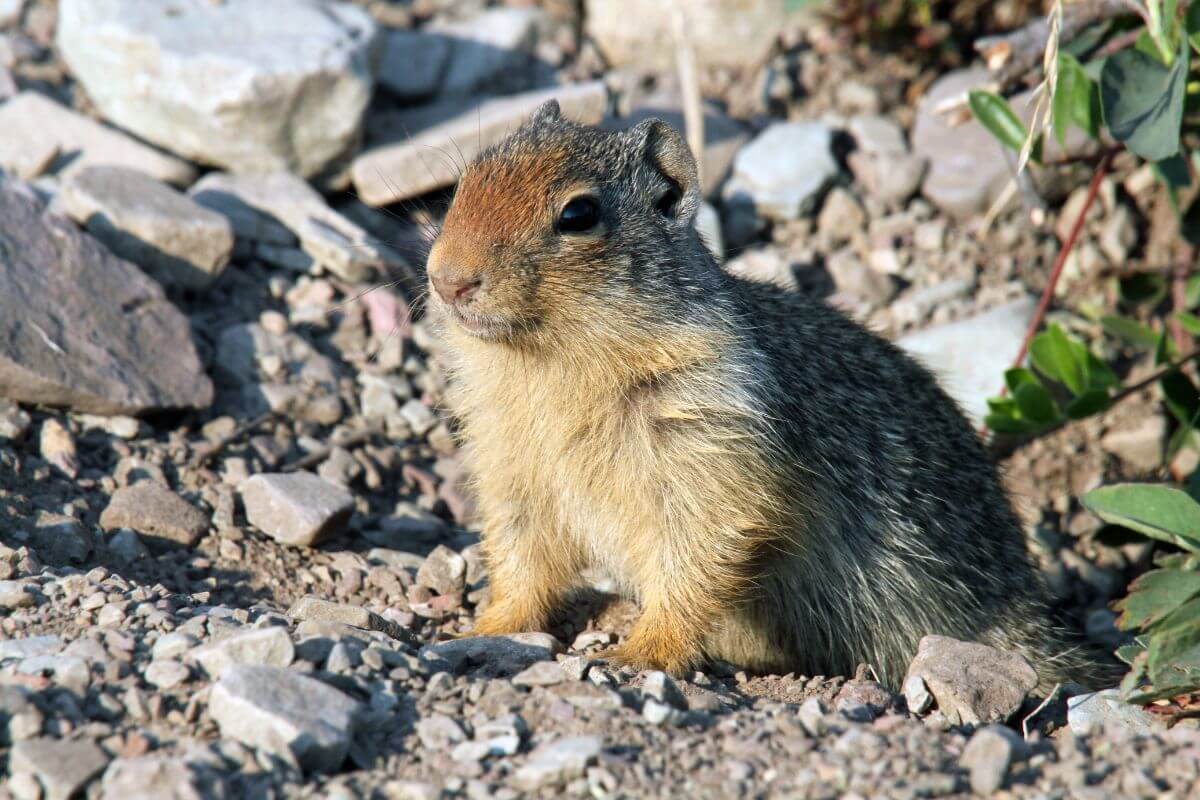
The Columbian Ground Squirrel, scientifically named Spermophilus columbianus, is unique to western Montana. It is distinct not only in its habitat but also in its appearance. Its coloration makes it easily recognizable.
Here are some essential facts about Montana’s Columbian Ground Squirrel:
- Unique Coloration – The Columbian Ground Squirrel boasts a white-speckled brown, black, and gray coat on its head and back. You can’t miss the reddish-brown (rufous) fur on its nose, forelegs, and hindquarters. To top it off, it has a reddish-black tail and white markings around its eyes.
- Size and Weight – Adult Columbian Ground Squirrels have a head-to-body length of 10 to 12 inches (25.4 to 30.5 cm) and a tail of 3 to 5 inches (7.6 to 12.7 cm). On average, they weigh more than 16 ounces (454 g).
- Habitat and Diet – Columbian Ground Squirrels are found in open alpine meadows, dry grasslands, and brushy areas. They are herbivores, and most of their diet consists of grasses, stems, leaves, bulbs, fruits, and seeds. However, they occasionally mix in birds, insects, and other small animals.
- Hibernation – The Columbian Ground Squirrel hibernates, like many squirrels. It can sleep seven to eight months of the year, relying on its fat stores to get through the winter.
Encountering a Columbian Ground Squirrel in Montana is a special experience. Their unique features and behavior add to the state’s rich tapestry of wildlife.
What Additional Methods Are Used to Control Squirrels in Montana?
Montana’s vast lands and diverse ecosystems offer a unique way to manage squirrel populations. Besides traditional methods, this section touches on coexistence strategies that respect the natural balance. Let’s examine some of Montana’s effective approaches to managing squirrels.
Use Feeders, Plants, and Trees to Control Tree Squirrels
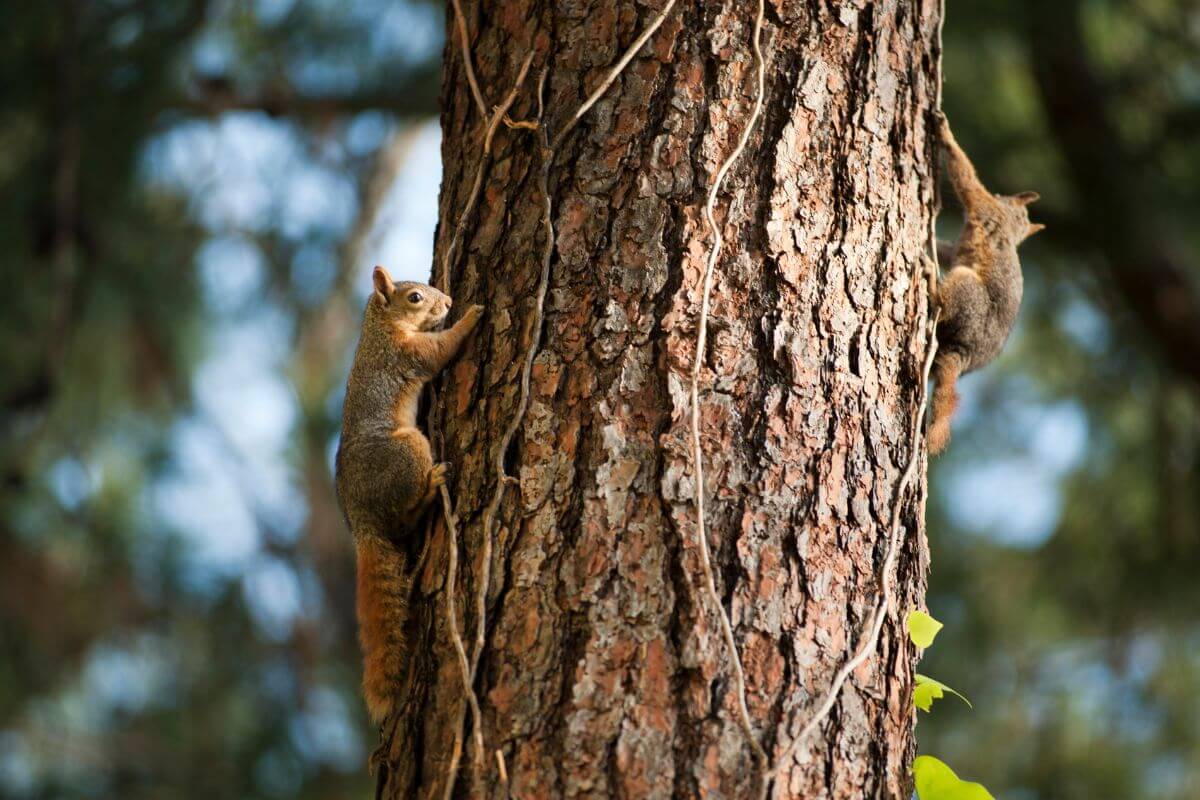
Dealing with squirrels in Montana can be a challenge. These critters are smart and very good at getting into places they’re not supposed to be. Here’s a guide on handling squirrel invasions from your backyard to your home.
If you’re trying to keep squirrels away from your bird feeders, you’re in for a bit of a battle. Squirrels are like ninjas – they can climb just about anything. However, there are some tricks you can try:
- Feeders – It’s hard to make feeders completely squirrel-proof, but you can make it tough for them. Use baffles or choose feeders that are hard for squirrels to climb. Also, keep feeders away from trees and structures that squirrels can jump from.
- Plants – Squirrels have a thing for tulips and crocus bulbs. To protect your garden, cover the soil with mesh netting. And if you’re planting flowers, go for daffodils. Squirrels don’t like the taste of them.
- Trees and Structures – Squirrels can jump onto your roof from trees. To stop them, wrap sheet metal around the trees so they can’t get a grip. Remember to loosen the metal once a year to let the tree grow.
Now, about repellents. The truth is, there’s nothing that works well against squirrels. Things that keep rats and mice away don’t do much to squirrels. And no sprays or poisons are safe and effective squirrel repellents.
If a squirrel finds its way into your home, you must get it out. Squirrels are most active during the day, so you can block their entry point while they’re out. Or, you can use a one-way door that lets them leave but not come back.
Trapping is often the best way to deal with squirrels. Once they’re out, fix up the hole they used to get in. This will stop other squirrels or animals from moving in. If a squirrel gets stuck in your chimney, don’t worry. Lower a rope down for them to climb out. Squirrels will find their way out.
Squirrel problems need practical solutions. Understanding how to manage feeders, plants, and entry points can keep these agile creatures from causing too much trouble. It’s about outsmarting them, not hurting them.
Use Fencing, Flooding, and Crop Rotation to Control Ground Squirrels
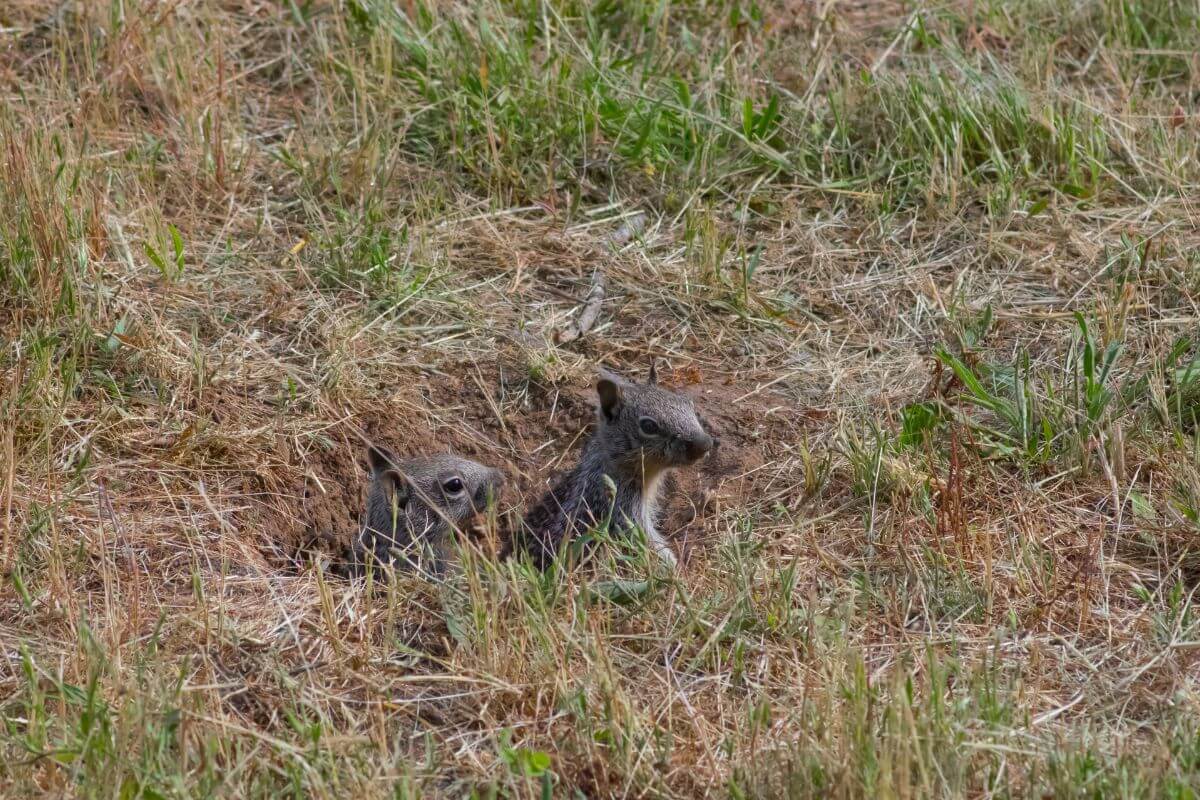
It’s important to use the right methods when dealing with ground squirrels in Montana. This is especially important because the state also houses the white-tailed prairie dog, a protected species. So, before taking any action, ensure you’re targeting the right rodent.
Here are the most effective control methods for managing ground squirrels in Montana:
- Exclusion (Fencing) – Fencing can work well in specific spots around individual trees, gardens, or flower beds. It’s a good option for small areas but not practical for large spaces because of the cost and effort involved.
- Flooding – Flooding their burrows now and then can convince ground squirrels to find a new home.
- Poisons – For larger squirrel populations, poisons like rodenticides are cost-effective. However, they can only be used by licensed pest control professionals. Fumigants are another option that works well on burrowing animals.
- Crop Rotation – This method, combined with tillage, can make the area less appealing to ground squirrels. Keeping grass tall can also help reduce squirrel numbers.
Each of these methods plays a role in ground squirrel control in Montana. To choose the most effective approach, you should always consider the size of the infestation and the area you’re dealing with.
Montana Squirrels Final Thoughts
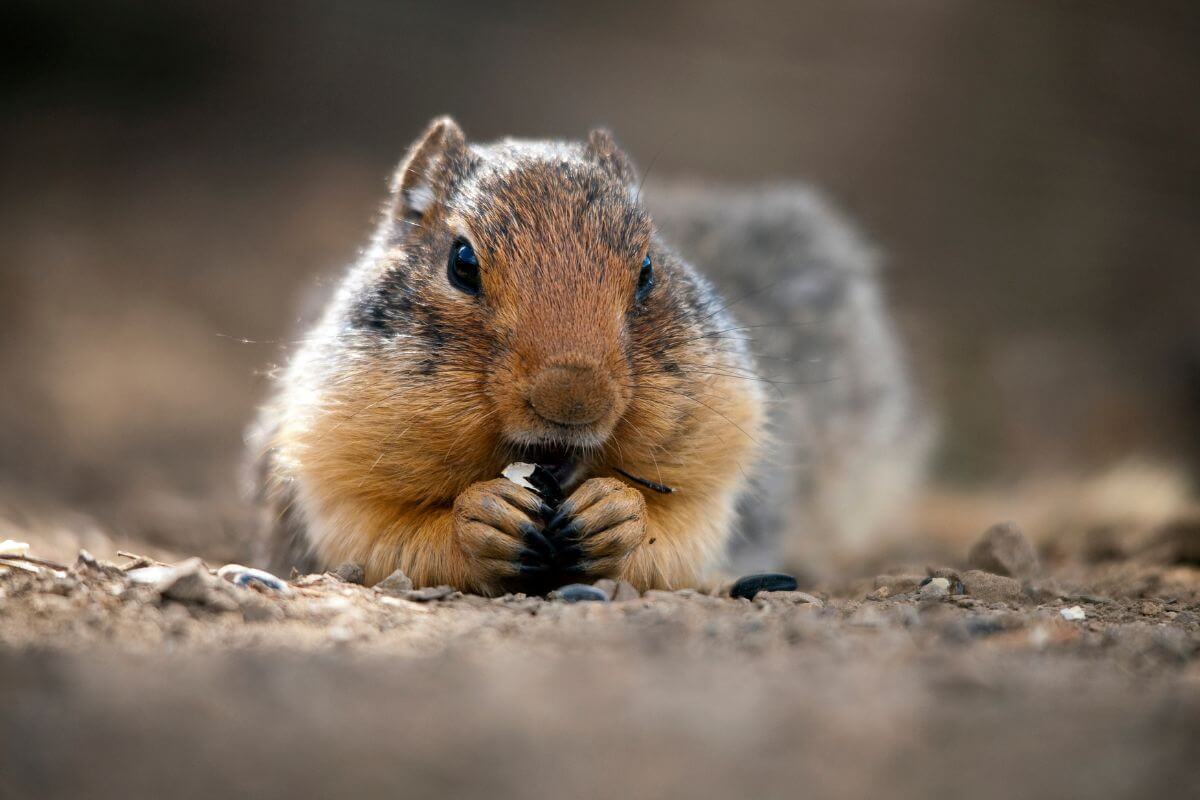
Montana is home to various squirrel species, each with a unique role in the state’s ecosystem. Red squirrels are vital in the northern forests. Northern flying squirrels are known for their ability to glide. Fox squirrels pose challenges in urban areas, while tree squirrels are diverse and important.
These small mammals play an important role in the state’s ecosystem by dispersing seeds and serving as prey for larger predators. Managing squirrel populations involves trapping and shooting. This shows the need for balance and respect in wildlife control.
Montana’s squirrels represent the rich life in the state. They remind us to appreciate and protect the nature around us.
Montana Squirrels FAQs
1. What Kind of Squirrels Are in Montana?
You can find several species of squirrels in Montana, including tree squirrels and ground squirrels.
2. Do Montana Squirrels Hibernate?
Montana squirrels, like the Red Squirrel or pine squirrel and some ground squirrels, stay active during the winter and rely on stored food and insulated nests to survive. However, some tree-dwelling squirrels may be less active in winter without hibernating.
3. Can You Hunt Squirrels in Montana?
Certain squirrels in Montana are considered nongame species and can be hunted year-round without a license.
4. Is It Legal to Own a Squirrel in Montana?
Massachusetts and Montana allow people to have pet squirrels, but only flying squirrels are permitted.
5. What Is the Most Common Squirrel in Montana?
The most prominent ground squirrel in Montana is the Richardson’s ground squirrel (Urocitellus richardsonii), which prefers meadow and grassland habitats.
Embrace the spirit of Montana’s culture through these articles:
- Montana Spider Guide
- Wildlife of Montana in Winter
- Winter Birds in Montana
- Guide to Montana Wolves
- https://fwp.mt.gov/conservation/living-with-wildlife/tree-squirrels
- https://fwp.mt.gov/conservation/living-with-wildlife/ground-squirrels
- https://www.montana.edu/extension/broadwater/blog-article.html?id=22074
- http://mars.unh.edu/natureworks/columbiangroundsquirrel.htm
- https://fwp.mt.gov/binaries/content/assets/fwp/montana-outdoors/2011/foxsquirrel.pdf
- https://www.montana.edu/extension/sanders/Small%20Game%20And%20Furbearers%202016.pdf
- https://www.montana.edu/extension/flathead/documents/ag/yard-garden/Ground%20Squirrels.pdf
- https://www.flickr.com/photos/michaelklotz/50504653311

